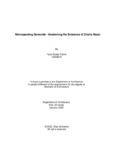| dc.contributor.advisor | Reza, Mohammad Habib | |
| dc.contributor.advisor | Faruk, Mohammad | |
| dc.contributor.author | Fahim, Fazle Rubby | |
| dc.date.accessioned | 2023-07-25T10:27:23Z | |
| dc.date.available | 2023-07-25T10:27:23Z | |
| dc.date.copyright | 2022 | |
| dc.date.issued | 2022-01 | |
| dc.identifier.other | ID: 14208014 | |
| dc.identifier.uri | http://hdl.handle.net/10361/19000 | |
| dc.description | This thesis is submitted in partial fulfillment of the requirements for the degree of Bachelor of Architecture, 2022. | en_US |
| dc.description | Cataloged from PDF version of thesis. | |
| dc.description | Includes bibliographical references (pages 95-96). | |
| dc.description.abstract | Three million people were ruthlessly killed in Bangladesh in 1971, however, the
genocide is still recognized globally. The victims included ordinary people, students,
powerful leaders, intellectuals, and religious minorities. The Pak militants and their
collaborators systematically spirited people away, killed, and dumped dead bodies in
either the killing site or separate mass graves. These killing sites, mass graves, and
torture cells are disseminated around the country
Unfortunately, because international journalists were forced to flee the country and
important local journalists were killed or went into hiding, there was little visual
documentation of these atrocities. After independence, only a few major mass graves
were conserved, protected, and recognized as historical sites. Through this research,
the mass killing site from Zinzira would be identified and find a probable space of
massacre to create a memorial journey balancing the existing functions from the site thus creating harmony between the subsisting programs and memory. | en_US |
| dc.description.statementofresponsibility | Fazle Rubby Fahim | |
| dc.format.extent | 96 pages | |
| dc.language.iso | en | en_US |
| dc.publisher | Brac University | en_US |
| dc.rights | Brac University theses are protected by copyright. They may be viewed from this source for any purpose, but reproduction or distribution in any format is prohibited without written permission. | |
| dc.subject | Genocide | en_US |
| dc.subject | Memorial | en_US |
| dc.subject | War | en_US |
| dc.subject | Context | en_US |
| dc.subject | Neo-contextual | en_US |
| dc.subject | Bazar | en_US |
| dc.subject | River | en_US |
| dc.subject | Neighborhood | en_US |
| dc.subject | Connectivity | en_US |
| dc.subject.lcsh | Architecture--Bangladesh--History. | |
| dc.title | Retrospecting genocide: Awakening the existence of Zinzira Bazar | en_US |
| dc.type | Thesis | en_US |
| dc.contributor.department | Department of Architecture, Brac University | |
| dc.description.degree | B. Architecture | |

